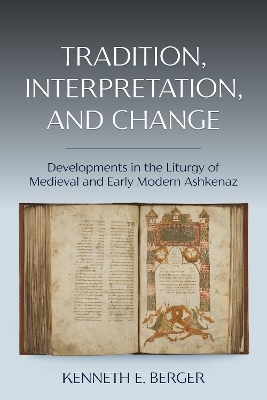
Tradition, Interpretation, and Change
Hebrew Union College Press,U.S. (Verlag)
978-0-87820-170-9 (ISBN)
Minhag (custom) played a far greater and far more important role in medieval Ashkenazic society than in any other Jewish community. In upholding the authority of a custom, halakhic authorities frequently asserted that "custom prevails over halakhah." Furthermore, Ashkenazic authorities asserted that Ashkenazic custom is more authentic than the customs of other Jewish communities, including those of Sepharad (Spain). Given the importance attributed to minhag and the influence of the siddur commentaries of the circle of Hassidei Ashkenaz, which emphasize the precise formulation of liturgical texts, one might assume that Ashkenazic Jewry was committed to preserving ancestral custom and opposed to liturgical change. However, the reality is that the liturgy of Ashkenaz was never static. From a very early time, new liturgies and liturgical practices were incorporated into the service, the inclusion of various prayers was challenged, and variant readings of prayers became standard. Tradition, Interpretation, and Change focuses on developments in the Ashkenazic rite, the liturgical rite of most of central and eastern European Jewry, from the eleventh century through the seventeenth. Kenneth Berger argues that how a prayer or practice was understood, or the rationale for its recitation or performance, often had a profound effect on whether and when it was to be recited, as well as on the specific wording of the prayer. In some cases, the formulation of new interpretations served a conservative function, as when rabbinic authorities sought to find new, alternative explanations which would justify the continued performance of practices whose original rationale no longer applied. In other cases, new understandings of a liturgical practice led to changes in that practice, and even to the development of new liturgies expressive of those interpretations. In Tradition, Interpretation, and Change, Berger draws upon a wide body of primary sources, including classical rabbinic and geonic works, liturgical documents found in the Cairo genizah, medieval codes, responsa, and siddur commentaries, minhag books, medieval siddur manuscripts, and early printed siddurim, as well as a wealth of secondary sources, to provide the reader with an in-depth account of the history and history of interpretation of many familiar and not-so-familiar prayers and liturgical practices. While emphasizing the role that the interpretation ascribed to various prayers and practices had in shaping the liturgy of medieval and early modern Ashkenaz, Berger illustrates the degree to which Sephardic and kabbalistic influences, concern for the fate of the dead, the fear of demons, and the desire for healing and divine protection from a variety of dangers shaped both liturgical practice and the way in which those practices were understood.
Acknowledgments Introduction Tradition and Change Tradition: Conservative Influences on the Liturgy of Ashkenaz Interpretation and Change Ashkenaz and the Liturgy of Ashkenaz Sources for the Study of the Liturgy of Ashkenaz Printing and the Development of Ashkenazic Liturgy 1 The Old Will Be Renewed: Vehu Raḥ
um Interpreted and Reinterpreted The Recitation of Vehu Raḥ
um in Arvit Early Explanations for the Recitation of Vehu Raḥ
um in Arvit 68 Sixteenth- and Seventeenth-century Authorities on the Recitation of Vehu Raḥ
um Conclusion Excursus: Vehu Raḥ
um in the Rite of the Land of Israel 2 Preserving the Old Barukh Adonai Le'olam Berakhah Aḥ
at Me'ein Sheva The Recitation of Kiddush in the Synagogue Conclusion 3 Interpretation and Praxis Bameh Madlikin The Torah Service: Taking Out and Returning the Torah Summary and Conclusion 4 The Twelfth Century: Aleinu Introduction The Origin of Aleinu The Inclusion of Aleinu in the Daily Service The Evidence of the Siddurim Explanations for the Inclusion of Aleinu in the Daily Service Summary and Conclusion 5 Sephardic Influences: The Sixteenth and Seventeenth Centuries Introduction The Ḥ
atimah of Hashkiveinu The Ḥ
atimah of Barukh Adonai Le'olam The Concluding Petition of the Kedushat Hayom Blessing 6 Kabbalistic Influences: The Seventeenth Century Introduction Hama'ariv Aravim The Conclusion of Aleinu Berikh Shemei Kabbalat Shabbat 7 Save Us From Enemies, Sword, Famine, and Sorrow Hatavat Ḥ
alom Seventy-two Verses Pitum Haketoret 8 Shelter Us Under Your Wings The Expansion of the Arvit Service on Saturday Night Mourner's Kaddish Summary and Conclusion Excursus: The Text of Veyiten Lekha Excursus: The Repetition of the Last Verse of Veyehi No'am 9 You will not Fear the Terror of Night Introduction Barukh Adonai Le'olom Berakhah Aḥ
at Me'ein Sheva Bameh Madlikin Additions to Arvit on Saturday Night Veyehi No'am Hashkiveinu Conclusion Excursus: Other Textual Issues in Hashkiveinu 10 Conclusion Varieties of Interpretation Liturgical Factors Multiple Interpretations Tables Table A Vehu raḥ
um in the Rite of the Land of Israel: Shabbat Table B The Torah Service in the Early Ashkenazic Rite Table C Additions to the Torah Service by the Sixteenth Century Table D Seventeenth-century Additions to the Torah Service Table E Psalm 29 Table F Adoption of Sephardic Textual Variants in Ashkenazic Siddurim Table G Siddurim Which Include the Text of kaddish shalem at the Conclusion of the Weekday shaḥ
arit Service Table H Veyiten Lekha Table I Hashkiveinu Table J Haskiveinu: Variant Texts: Shabbat
| Erscheinungsdatum | 18.03.2019 |
|---|---|
| Sprache | englisch |
| Maße | 152 x 228 mm |
| Gewicht | 860 g |
| Themenwelt | Geschichte ► Allgemeine Geschichte ► Mittelalter |
| Geschichte ► Teilgebiete der Geschichte ► Religionsgeschichte | |
| Geisteswissenschaften ► Religion / Theologie ► Judentum | |
| Sozialwissenschaften ► Soziologie ► Spezielle Soziologien | |
| ISBN-10 | 0-87820-170-X / 087820170X |
| ISBN-13 | 978-0-87820-170-9 / 9780878201709 |
| Zustand | Neuware |
| Haben Sie eine Frage zum Produkt? |
aus dem Bereich


